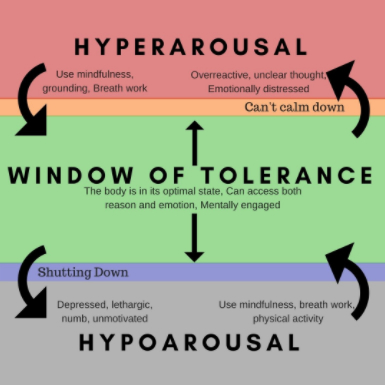Tamie Pushlar - Therapy Blog
Window of Tolerance
posted by Tamie Pushlar at 2022-03-24 18:34:00

As an EMDR therapist, I speak with my clients regarding the Window of Tolerance. The optimal window was originally developed by Dr. Dan Siegel to note the “optimal zone of arousal to function”. The optimal window is when a person is functioning in the window of tolerance so they are able to manage everyday tasks, emotions, and body sensations. When a person is not able to maintain regulation, they either enter hyperarousal or hypoarousal.
Hyperarousal is when a person feels irritated, anxious, and/or angry. One may have a difficult time focusing and may feel that they have excess energy. Hypoarousal is when one feels depressed, numb, unmotivated, and/or detached. A person may feel like their body is shutting down.
In both states, a person is not able to effectively process external stimuli because the prefrontal cortex (the “thinking brain”) goes offline, so to speak. When a person has a difficult time maintaining life within the window of tolerance, they may start to notice a negative impact on their mental and physical health. If a person finds themselves, or a loved one, in that situation it is important to reach out to a trained mental health therapist to develop an increased understanding and skills to manage the various states of functioning.
How does an EMDR therapist help?
As an EMDR therapist, I would start by teaching the person about the Window of Tolerance. The person would begin to have increased awareness about the optimal level of arousal, hyperarousal, and hyperarousal. The person will also uncover which experiences or events may cause them to become hyperaroused or hypoaroused. Most importantly, they will learn skills and develop resources to increase their window of tolerance and to assist when they are hyper or hypo aroused.
Example:
Client C comes to therapy because they are having trouble sleeping at night (insomnia, nightmares). They notice some days they do not want to go to work; they have missed over 10 days of work this year, and it is only July. Other days, they find themselves becoming agitated with their partner and children. They find themselves not spending time with friends and they spend too many hours watching TV.
When C meets with an EMDR therapist, they learn about the Window of Tolerance. They recognize that when they are feeling agitated, they feel a heavy sensation in their chest and feel anxious. They also start to recognize that these sensations and emotions often happen after having a bad night of sleep, due to insomnia or nightmares.
The EMDR therapist explains to them that these feelings and sensations are hyperarousal. The therapist explains to the person about their “fight or flight” system. The therapist and C work together to develop a list of skills to try when they are hyperaroused.
C reports that alternate nose breathing, spiraling technique, and taking walks help when they are hyperaroused. They practice those skills while the EMDR therapist helps C uncover why they are having sleep difficulties. Through conversation, the therapist discovers that C was sexually abused as a child and the abuse often occurred at night.
When C feels comfortable with using the skills and resources, C and the therapist will develop a treatment plan to write down past, present, and future targets related to the abuse. Once the targets are identified, C and the therapist will continue the EMDR process (stages 3-8).
After C has all the resources/skills and has effectively worked through the treatment plan, C’s Window of Tolerance will be wide enough to manage everyday stressors.
--------------------
In conclusion, the purpose of EMDR therapy is for people to rediscover adaptive resources and skills to manage stress, in addition to assisting in healing the wounds that may have contributed to a small Window of Tolerance. Once a person has a larger Window of Tolerance to manage most of the life stressors, it is important to continue taking care of oneself by practicing adaptive coping skills.

